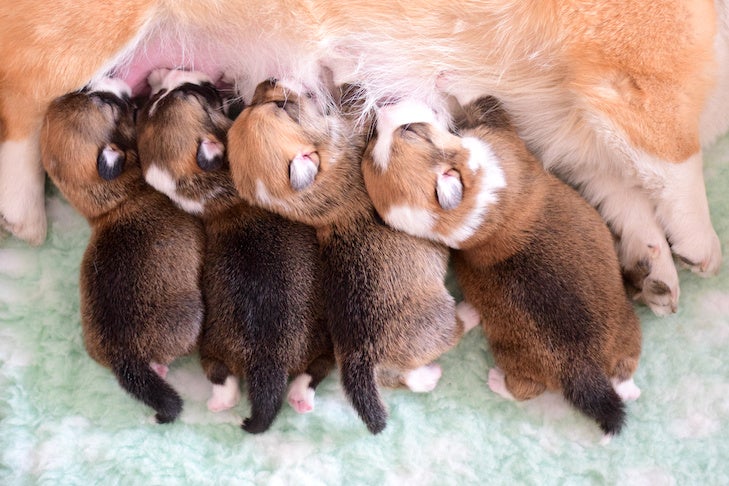How long between litters for dogs? The answer varies based on several factors.
Most dogs can have a litter every six months to a year. Understanding the breeding cycle of dogs is crucial for responsible pet ownership. Many owners wonder about the right time to breed their dogs again. It’s important to consider the dog’s age, health, and breed.
Breeding too frequently can harm the dog and the puppies. Each dog is unique, and their needs can differ widely. Knowing how long to wait between litters helps ensure the health of the mother and her puppies. This knowledge can lead to better decision-making for breeders and pet owners alike. Let’s explore this topic further to provide clarity and guidance.

Credit: mashable.com
Table of Contents
Introduction To Dog Reproduction
Understanding dog reproduction is essential for dog owners. Responsible breeding helps maintain the health of dogs and their puppies. Knowing the breeding cycle and timing between litters is key. This guide covers important aspects of canine reproduction.
The Basics Of Canine Fertility
Canine fertility involves several stages. The heat cycle is a crucial part of this process.
- Proestrus: Lasts about 9 days. Swelling and bleeding occur.
- Estrus: Lasts 5 to 14 days. This is the fertile period.
- Diestrus: Lasts about 60 days. The dog may be pregnant.
- Anestrus: The resting phase. It can last several months.
Female dogs usually go into heat twice a year. Each cycle can vary by breed.
Importance Of Responsible Breeding
Responsible breeding is vital for dog health. It ensures puppies are healthy and well-adjusted.
- Breeders should understand genetics.
- Health screenings are necessary for both parents.
- Breeding too often can harm the mother.
Responsible breeders wait at least one year between litters. This allows the mother to recover fully.
| Interval Between Litters | Recommended Time |
|---|---|
| Small Breeds | 1 Year |
| Medium Breeds | 1 to 2 Years |
| Large Breeds | 2 Years |
Waiting ensures the health of the mother and her puppies. Breeding responsibly helps maintain a good quality of life for all dogs involved.
The Canine Estrous Cycle
The canine estrous cycle plays a key role in dog breeding. It is the process through which female dogs go through various stages to prepare for mating. Understanding this cycle helps dog owners manage breeding times effectively. The cycle includes distinct phases, each with specific signs and behaviors.
Phases Of The Heat Cycle
The canine heat cycle has four main phases:
- Proestrus: Lasts 7-10 days. The female attracts males but is not ready to mate.
- Estrus: Lasts 5-14 days. This is the fertile phase. The female is receptive to males.
- Diestrus: Lasts about 60 days. The female is no longer receptive. This phase occurs whether or not the dog is pregnant.
- Anestrus: The resting phase. It can last several months. This phase prepares the female for the next cycle.
| Phase | Duration | Behavior |
|---|---|---|
| Proestrus | 7-10 days | Attracts males, not receptive |
| Estrus | 5-14 days | Receptive to mating |
| Diestrus | 60 days | Not receptive, may be pregnant |
| Anestrus | Several months | Resting phase |
Signs Of Receptiveness In Females
Recognizing signs of receptiveness is crucial for successful breeding. Here are some common signs:
- Swelling of the vulva: Noticeable increase in size.
- Blood discharge: Light to moderate bleeding occurs.
- Behavior changes: Increased affection and restlessness.
- Increased urination: More frequent trips outside.
- Attracts male dogs: Males may show heightened interest.
Understanding these signs helps determine the best time for mating.
Optimal Breeding Age For Dogs
Choosing the right age for dog breeding is important. It affects the health of the puppies and the mother. Understanding the optimal breeding age helps ensure healthy litters.
Factors Determining Breeding Age
Several factors influence the best age for breeding dogs:
- Breed: Different breeds mature at different rates.
- Size: Smaller breeds often mature faster than larger breeds.
- Health: A dog’s health can affect breeding readiness.
- Temperament: A dog’s behavior can impact breeding success.
Most dogs are ready to breed between 1 and 2 years old. Waiting until they reach full maturity is best. This varies by breed.
Health Implications For Young And Older Dogs
Breeding young dogs can pose risks. Their bodies may not be ready. This can lead to complications during pregnancy and birth.
Older dogs also face risks. They may have health issues that affect breeding. Puppies may inherit these problems. Here are some health implications:
| Age Group | Health Risks |
|---|---|
| Young Dogs (under 2 years) | Inexperienced, potential health complications |
| Older Dogs (over 5 years) | Higher chance of genetic disorders, difficulty in pregnancy |
Consult a veterinarian before breeding. They can provide guidance on the best age for your dog.
Time Between Litters
Understanding the time between litters is important for dog breeders. This period affects the health of the mother and the puppies. Breeding too frequently can lead to serious health issues. It is crucial to know the recommended rest times.
Recommended Rest Period For Females
Most experts recommend a rest period of at least 18 months between litters for female dogs. This allows the mother to recover fully. It is vital for her physical and mental health. A well-rested dog can produce healthier puppies.
Here are some key points to consider:
- Female dogs should have a break after each litter.
- Breeding too often can lead to exhaustion.
- Rest helps in maintaining the mother’s overall health.
Each dog is different. Factors like age and health influence the right rest period. Consult a veterinarian for specific advice.
Risks Of Back-to-back Breeding
Breeding a dog back-to-back can pose serious risks.
- Health Issues: Increased risk of diseases.
- Exhaustion: The mother may become overly tired.
- Puppy Health: Puppies may be weaker.
Here’s a simple table showing risks:
| Risk | Description |
|---|---|
| Physical Health | Can lead to weight loss and other health problems. |
| Puppy Quality | Puppies may lack necessary nutrients. |
| Emotional Stress | The mother dog may experience stress and anxiety. |
Understanding these risks is vital. Responsible breeding protects both the mother and her puppies.
Health Screening Before Breeding
Health screening is vital before breeding dogs. It ensures the health of both the mother and her puppies. This process can help prevent genetic issues and diseases. Proper screening leads to healthier litters.
Genetic Testing For Hereditary Conditions
Genetic testing is important for breeding dogs. It helps identify hereditary conditions that can affect puppies. Testing can reveal if a dog carries genes for specific diseases.
- Common hereditary conditions include:
- Hip dysplasia
- Elbow dysplasia
- Progressive retinal atrophy
- Von Willebrand’s disease
Breeders should perform genetic tests on both parents. Knowing their genetic health helps make informed decisions. This reduces the risk of passing on genetic disorders.
Regular Health Check-ups For Breeding Dogs
Regular health check-ups are essential for breeding dogs. A veterinarian can assess their overall health. These check-ups should include:
- Physical examination
- Vaccination updates
- Dental health check
- Parasite screening
Check-ups ensure that the breeding dog is fit for pregnancy. Healthy dogs are more likely to have healthy puppies.
Remember, health screening is not just about the dogs. It’s about their future puppies. A healthy start leads to a happy life.
Nutrition And Care For Pregnant Dogs
Proper nutrition and care are essential for pregnant dogs. Good food helps the mother and puppies grow healthy. It is important to meet their special needs during pregnancy.
Dietary Needs During Pregnancy
Pregnant dogs need a balanced diet. Their nutritional needs change as the puppies grow. Here are some key points:
- Increase protein intake. Protein helps build tissues.
- Include healthy fats. Fats provide energy.
- Choose high-quality dog food. Look for food labeled for pregnant or nursing dogs.
- Provide fresh water. Hydration is vital for health.
Consider switching to a high-calorie dog food. This helps meet increased energy needs.
| Nutrient | Importance |
|---|---|
| Protein | Supports muscle and tissue growth |
| Fats | Provides energy and supports brain development |
| Vitamins | Boosts immune system and overall health |
| Minerals | Supports bone and teeth development |
Monitoring Health And Activity Levels
Keep a close eye on your pregnant dog’s health. Regular check-ups help catch any issues early. Here are some tips:
- Visit the vet regularly. Ensure she is healthy.
- Watch for changes in appetite. A sudden drop may indicate problems.
- Check for weight gain. Healthy weight gain is normal.
- Limit intense exercise. Short walks are better.
Provide a safe and quiet space for rest. This helps reduce stress.
Monitor her behavior. Changes may signal discomfort or health issues.
Postpartum Care And Litter Management
After a dog gives birth, caring for her and her puppies is vital. This period requires attention to both the mother’s health and the puppies’ development. Proper management ensures a smooth transition for everyone involved.
Recovery Care For The Mother
Recovery is essential for the mother dog. She needs time to heal after giving birth. Here are some key points to consider:
- Provide a quiet and comfortable space.
- Ensure she has access to fresh water and food.
- Monitor her for signs of infection, such as fever or swelling.
- Limit physical activity for at least two weeks.
Regular vet check-ups are crucial. They can track her recovery and ensure she is healthy.
Socialization And Health Care For Puppies
Puppies need proper care and socialization. Start this process early. Here are some tips:
- Keep the puppies in a warm, safe area.
- Introduce them to gentle handling from humans.
- Schedule vet visits for vaccinations and health checks.
- Observe their development and behavior.
Early socialization helps puppies become well-adjusted adults. They should meet different people and environments.
Following these steps ensures the health of both the mother and her puppies. This care sets the stage for their future well-being.
Legal And Ethical Considerations
Breeding dogs involves many legal and ethical issues. Understanding these factors is crucial for responsible dog owners. Laws vary by region. Knowing the rules helps ensure the health and welfare of both mother and puppies.
Breeding Regulations And Laws
Breeding regulations are important. They protect dogs and ensure responsible breeding. Here are some key points:
- Licensing: Some areas require breeders to have a license.
- Health checks: Many regions require health screenings for breeding dogs.
- Age restrictions: Laws may limit the age at which dogs can breed.
- Record keeping: Breeders often must keep detailed records of litters.
Violating these laws can lead to fines or loss of breeding rights. Always check local regulations before breeding.
Ethical Breeding Practices
Ethical breeding goes beyond laws. It ensures the well-being of all dogs involved. Here are some best practices:
- Wait time: Allow time between litters. This helps the mother recover.
- Health focus: Breed only healthy dogs. This reduces genetic issues.
- Socialization: Puppies should be socialized early. This prepares them for life.
- Care for all: Ensure proper care for both mother and puppies.
Responsible breeders prioritize the health and happiness of dogs. This builds a positive reputation in the community.
When To Spay Or Neuter
Deciding when to spay or neuter your dog is important. This choice affects their health and behavior. Many factors influence the timing of this procedure. Understanding these factors helps you make the best decision for your pet.
Benefits Of Spaying/neutering
Spaying or neutering your dog offers many benefits:
- Prevents unwanted litters: Helps control the pet population.
- Reduces health risks: Lowers chances of certain cancers.
- Improves behavior: Can decrease aggressive tendencies.
- Less marking: Reduces territorial marking in males.
- Longer lifespan: Spayed and neutered dogs often live longer.
Timing For Spaying/neutering
The right age for spaying or neutering varies. Here are some general guidelines:
| Dog Size | Recommended Age |
|---|---|
| Small Breeds | 6 to 9 months |
| Medium Breeds | 9 to 12 months |
| Large Breeds | 12 to 18 months |
Consult your veterinarian for specific advice. They can recommend the best timing based on your dog’s health and breed.
Spaying or neutering can help your dog live a healthier life. Each dog is unique, so consider their individual needs.

Credit: www.akc.org
Conclusion: Fostering Responsible Breeding
Breeding dogs requires careful thought and care. Responsible breeding ensures the health of both the mother and her puppies. Understanding the right time between litters is crucial. This helps maintain the well-being of the dogs.
Summing Up Breeding Guidelines
Here are key guidelines for responsible breeding:
- Wait at least 18 months between litters.
- Limit the number of litters per dog. Three to four is ideal.
- Monitor the health of the mother dog.
- Ensure all puppies are placed in loving homes.
- Provide proper veterinary care during pregnancy.
Following these guidelines helps dogs stay healthy and happy. Each dog is different. Some may need more time to recover. Always consult a vet for personalized advice.
Promoting Dog Welfare Through Education
Education plays a vital role in responsible breeding. Here are ways to promote dog welfare:
- Share knowledge about breeding best practices.
- Encourage spaying and neutering to control pet populations.
- Support local shelters and rescues.
- Educate potential dog owners on responsible pet care.
Responsible breeding leads to healthier dogs. It protects their future. Learning and sharing knowledge benefits everyone.
:strip_icc()/different-types-of-cat-litter-4688913-hero-3f1c939bf51f4e4cb30fe719b1f57189.jpg)
Credit: www.thesprucepets.com
Frequently Asked Questions
How Long Should I Wait Between Dog Litters?
The recommended wait time between dog litters is typically around 18 months to 2 years. This allows the mother dog to recover physically and mentally. Breeding too frequently can lead to health issues for both the mother and her puppies.
Always consult a veterinarian for personalized advice.
What Are The Risks Of Breeding Dogs Too Often?
Breeding dogs too frequently can cause numerous health risks. These include physical exhaustion, nutritional deficiencies, and potential complications during pregnancy. It can also impact the quality of the puppies. Regular breaks between litters help ensure the overall well-being of the mother and her offspring.
Can A Dog Be Bred Every Heat Cycle?
Breeding a dog every heat cycle is not advisable. Most experts recommend allowing at least one heat cycle between litters. This pause helps the dog recover and maintain her health. Frequent breeding can lead to serious health problems, so it’s essential to prioritize the dog’s well-being.
How Many Litters Can A Dog Have In Her Lifetime?
On average, a dog can have around 4 to 6 litters in her lifetime. However, this number can vary based on breed, health, and age. It’s important to consider the dog’s health and recovery time between litters. Responsible breeding ensures the welfare of both the mother and her puppies.
Conclusion
Understanding the right time between dog litters is essential. Proper spacing helps ensure the health of the mother and her puppies. A gap of at least a year is often recommended. This allows the mother to recover fully. Always consult a vet for personalized advice.
They can help you make the best decision for your dog. Regular check-ups are important for monitoring health. Keeping your dog healthy means happier litters. Careful planning leads to a better experience for everyone involved. Always prioritize the well-being of your dog.



